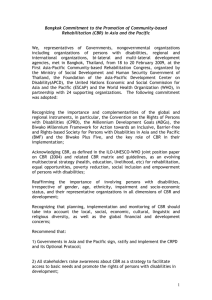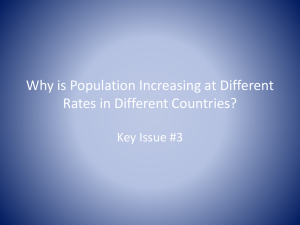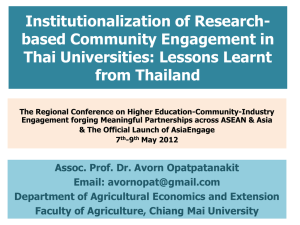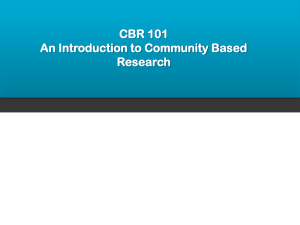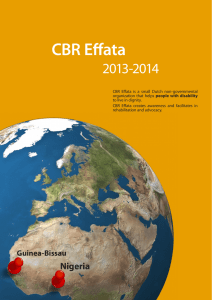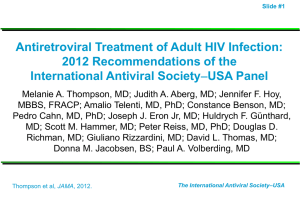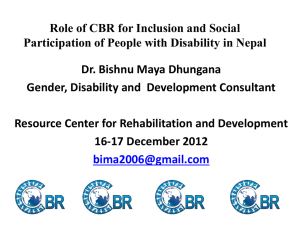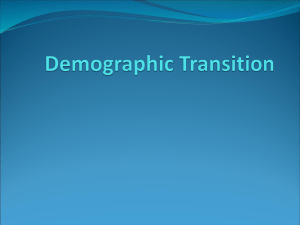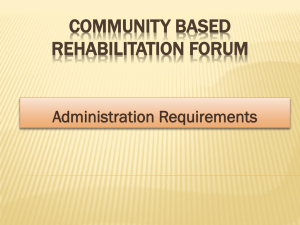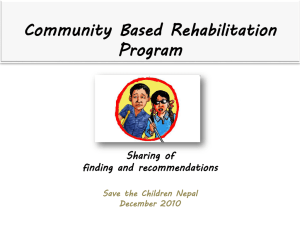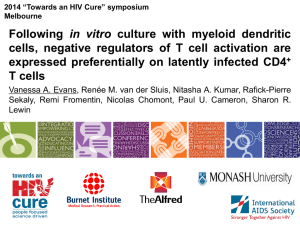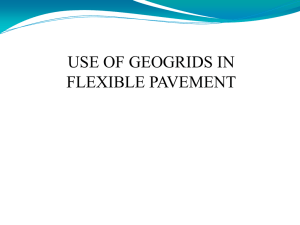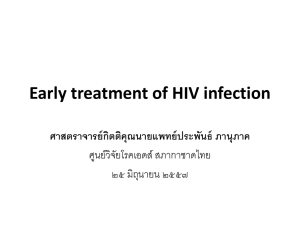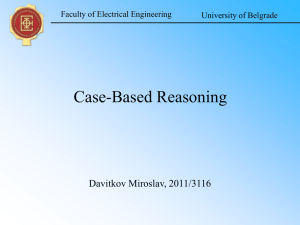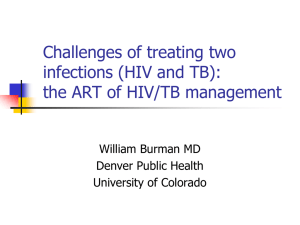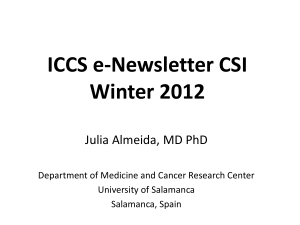Gender and Community Based Rehabilitation
advertisement
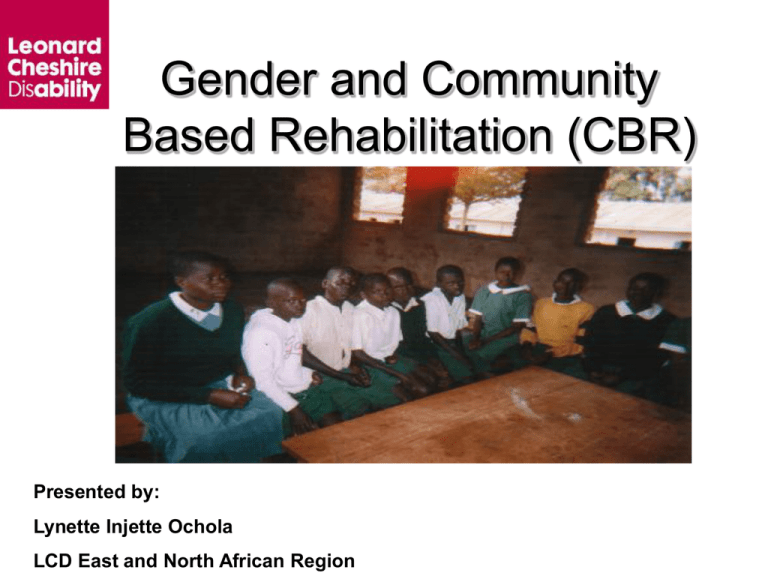
Gender and Community Based Rehabilitation (CBR) Presented by: Lynette Injette Ochola LCD East and North African Region What is CBR? • Emphasis on improving the lives of Persons With Disabilities (PWD’s) • It is a way forward for ingraining PWD’s into the development of their communities and themselves. CBR seeks to ensure that PWD’s have equal access to rehabilitation and other services and opportunities – health, education and income (WHO definition) Gender Mainstreaming • Mainstreaming a gender perspective is the process of assessing the implications for women and men of any planned action, including legislation, policies or programmes in any area and at all levels • It is a strategy for making concerns and experiences of women as well as men an integral part of the design, implementation, monitoring and evaluation of policies and programmes in all political, economic and societal spheres, so that women and men benefit equally and inequality is not perpetuated • The ultimate goal of mainstreaming is to achieve gender equality! • GENDER IS NOT EQUAL TO WOMEN! Why Gender and CBR? • Women and Girls who are disabled face double disadvantage: “Double Discrimination” and face further obstacles from accessing equal opportunity: education, health care, employment/income generating activities Why? • Poverty • Cultural challenges and strict religious norms in certain societies (Women’s role in the household, stigma of being disabled etc) • • • The effect of HIV/AIDS and Malaria which has a disproportionately higher prevalence rate on women and girls Social factors: domestic abuse, early pregnancies, rape, high rates of maternal mortality, Female Genital Mutilation In general, some disabilities are found significantly more often in girls and women (e.g., blindness, multiple sclerosis, osteoporosis) (World Bank) The importance of streamlining Gender and CBR • Women/girls constitute a dynamic force of any given society. Given the opportunity and recognition they can go a long way in contributing to sustainable development, improving quality of life for themselves and their peers/communities • Most successful Micro-credit schemes are operationalized by women (such as Merry Go rounds): issues of trust, commitment and responsibility • Enforcing basic human rights • Women have played the most active part in the fight against Malaria in sub-saharan Africa with their role in Ante-Natal clinics. The same can be said with HIV/AIDS prevention/awareness initiatives. • International documents such as the ILO, WHO, UNSECO draft “Guidelines” on CBR do not give any specific focus on Gender and CBR issues. • The document gives no articulate direction on “HOW?” to carry out CBR with an emphasis on placing attention to Women and Girls. For example women and girls, especially those with disability face very different health/medical challenges than males that require different approaches to address. • In many societies women trained as home based care providers make the best care providers and an extremely effective source for streamlining CBR initiatives. Trained Female Home Based Carers conduct home visits to perform basic physiotherapy for PWD’s in Nyanza Province, Kenya Success at a local project level: An example of the Oriang Inclusive Education Project, Nyanza Province-Kenya • Girls given an equal opportunity to learn in a schooling environment made conducive for disability • Boys and Girls learn together and show equal respect to each other • Important barrier crossed: Community and parents sensitized on the importance of sending girls with disability to school • Teachers (Male and Female), School Disability Committee’s, Community elders all play an active role in advocating for the cause of disability and inclusive education with an emphasis on creating equal opportunity for girls • Gender not just focused on Women/Girls to enhance CBR but an active participation of both male and female to encourage Inclusive Education as a means of fostering CBR Other successful contributing factors towards Gender mainstreaming into CBR: • Advocacy initiatives: Influencing policy at national and international levels to integrate Gender issues • Economic Empowerment: Creating Income Generating Activities that are appropriate to the pervading situation i.e. CBR - questions to ask • Has the development of CBR been a participatory approach or has it been more of a vertical ‘top down’ construction of concepts and issues? • Can certain CBR concepts as outlined in the draft guidelines be applied to the grassroot level? • Must not CBR guidelines be specific for every respective community, especially with relation to Gender? • Shouldn’t CBR be more than the adoption of an equal opportunities policy Way Forward • Need for specific, user friendly guidelines on CBR with a component for Gender and CBR that can be used at all levels: from policy makers to community health workers (more resources, time, stakeholder participation to validate and streamline such a document) • Increased community awareness initiatives • Increased training initiatives on Gender and CBR for teachers, parents, community elders/leaders, private co-operations, microcredit organizations, the media • Greater advocacy initiatives: measures to influence policy at a national and international level • Participatory involvement of girls/women with disabilities in design of projects, awareness sessions, conferences/seminars/trainings • Specific attention to certain health related standards that affect women/girls more and in turn affect their level of integration: e.g. sanitation • Adopting a radical political agenda which asserts not only women's needs but their rights to full participation in decision making at all levels • Effort should be directed towards ensuring that Gender and CBR initiatives are tackled in a manner that are ‘Bottom-Up’ and PARTICIPATORY. Anything else can not work at the field level! THANK YOU! East and North African Region P.O. Box 38748 Nairobi 00600 Kenya Email: info@lci-enar.org Website: www.lcint.org


